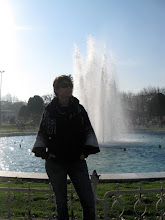As a night owl with a closeted penchant for drama and a not-so-closeted addiction to candy, Halloween was easily my favorite time of year as a kid. When I remember how Halloween was celebrated in my neighborhood, I remember all us kids spending hours, usually days or weeks, making or putting together costumes. There was the year I was a lollipop, with tan pants and a hot-pink-tissue-covered cardboard-and-hula-hoops sucker end (thanks, Mom). There was the year my sister was a robot (more cardboard, this time with tinfoil). And, of course, the old stand-by, "Gypsy" with lots of jewelry and scarves. The kids on the street, with whom we played throughout the year, would end up as one big knot of riotous, giggling candy-beggars. From house to house, if the lights were on and the decorations up, we rang or knocked. We met many a neighbor, young and old, recently moved into the neighborhood and always been there. At the end of the evening, we'd all get corralled into our respective homes, gorged on chocolate, sugar, and artificial dyes. Again, I ask what is not to love?
Fast-forward through the years of not trick-or-treating, to today. As a mother of school-aged kids, one of whom has the added love of all things Halloweenish by sharing her birthday with the month of the holiday, I am amazed at Halloween's image in this day and age. Apparently, this cherished tradition has become an excuse to scare the pants off the parents, not with zombie movies (my personal weakness) or ghost stories, but with check-for-sex-offenders and don't-meet-strangers advice. According to Halloween Safety Guide, parents' worries get to start at checking for local sex offenders ("just a fact of life now"), move on to every possible way to avoid your child being snatched off the roads ("In most cities it is not safe to let kids walk the streets by themselves."), dally through fire-proofing your kids' costumes (I wasn't planning on lighting it on fire, at least not with them in it), checking props for the potential to impale if the child should fall on it (really?), and (after more about not getting snatched) ends with crossing the street safely. To add to this list, other sources suggest checking your kids' candy to for loose wrappers, in case they were tampered with.
The instructions for kids parallel those for adults, including such warming ideas as "Never go to a stranger's house, or even ring the door bell, unless your parents are with you and say it is ok..." and my personal favorite: "If you can drive and are taking a bunch of friends to a party, make sure that you have enough gas to get there. You don't want to run out on a dark street, all alone, like a bad horror movie!" (What happened to those friends you were driving?? And, when did Halloween and its sequels offer us guidance to real life?)
Ok, in all seriousness, no one wants their kids to get snatched, including me. However, what are the odds, really, of being snatched? In 2009, the number of people under the age of 18 that were reported missing and determined to be missing "involuntarily" was 5,901 out of and estimated 74 million people under the age of 18. This gives us 8 children per 100,00 children, or 0.008 % chance. This includes children who were taken by a family member or other acquaintance, runaways and throwaways. In fact, kidnappings by strangers are so rare, I've started explaining to parents who ask, "but aren't you afraid," that if I wanted to decrease their odds of being kidnapped, I'd have to teach my children to fear only family and friends; strangers would be the safety. The rates of kidnappings, all together and by type of kidnapping, have NOT been getting bigger since we were kids. Currently, we are about the rate of abductions as we had in the 70s (lower than when I was running around in the 80s.) Despite all the voices telling us that "in these times" or "these days" or "no longer" safe, life for kids is safer than it was back in our day!
Alright, we are clear that the kiddos are not in danger from getting snatched. Now, what about tampered candy? We all grew up on the stories of razor blades in apples and poisoned candy; they must be true, right? What if I told you that they were nothing more than urban legends? Yep. There have been no confirmed cases of poisoned Halloween candy from strangers, no cases of any kind of threat to kids from the treats received from strangers. As far back as the researchers have been looking (into the 1950s), not a one. The kids are still safe.
While I haven't seen any statistics on the other scenarios (impaling oneself on props or running out of gas on a lonely road and discovering oneself in a horror movie), the straws are getting thinner. And, I'm still not planning on lighting my kid on fire. Cars are still a danger, and knowing how to cross the street on any day or night will serve kids well; so I can honestly say that that piece of advice is always a good one. A glow stick or reflective tape couldn't hurt, either.
On the other hand, there is a lot to be said for the advantages of the old-school Halloween:
- Independence! Kids are craving it and will reach for it wherever they can find it; better to make it available in safe and exciting ways, than through acting out. Better to have a walk around the neighborhood by themselves.
- Community! Yes, getting to know your neighbors is good for your kids and you, and your neighbors. Neighbors that are connected are stronger and safer.
So, I say, for your health, for your kids' safety, for your community and neighborhood, and just for the fun of it, go out and trick or treat!!

